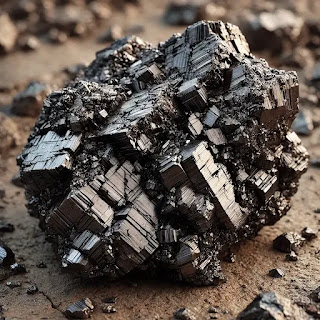Introduction
Maharashtra, one of India’s most industrialized states, is home to a variety of mineral resources. Although it constitutes only 4.3% of India’s total mineral wealth, the state plays a crucial role in India’s iron ore, bauxite, manganese, limestone, chromite, and coal production.
The geological structure of Maharashtra includes Archaean, Gondwana, and Dharwar rock formations, which harbor valuable mineral deposits. The minerals extracted from these regions support industries such as steel, cement, power generation, chemicals, and metallurgy.
For MPSC aspirants, understanding the distribution, economic significance, and industrial applications of minerals in Maharashtra is vital for Geography, Economy, and General Knowledge sections of the exam.
This blog provides an in-depth analysis of Maharashtra’s mineral wealth, covering key mining districts, major minerals, their applications, and industrial impact.
Overview of Maharashtra’s Mineral Wealth
- Maharashtra has limited mineral reserves due to its lava rock formation.
- The state's total potential mineral area is approximately 58,000 sq. km, accounting for 19% of Maharashtra’s total geographical area.
- The major mineral-rich districts include:
- Vidarbha Region: Bhandara, Chandrapur, Gadchiroli, Nagpur, Gondia, Yavatmal
- Konkan Region: Raigad, Ratnagiri, Sindhudurg, Kolhapur
- Maharashtra contributes significantly to India’s iron, bauxite, manganese, limestone, and coal production.
Major Minerals in Maharashtra
| Mineral | Key Locations |
|---|---|
| Manganese | Nagpur, Bhandara |
| Coal | Chandrapur, Yavatmal |
| Limestone | Yavatmal, Chandrapur, Nagpur |
| Iron Ore | Gadchiroli |
| Bauxite | Kolhapur, Ratnagiri |
| Dolomite | Chandrapur, Yavatmal |
| Gold | Nanded |
Top Minerals Found in Maharashtra (By Percentage of India's Total Reserves)
Major Minerals in Maharashtra
1. Iron Ore
- Maharashtra holds 20% of India’s total iron ore reserves.
- Largest deposits are in Gadchiroli, followed by Sindhudurg, Nagpur, and Bhandara.
- High-grade iron ore is found in Gadchiroli and Sindhudurg.
- Uses:
- Steel manufacturing
- Construction (bridges, buildings, railway tracks)
- Automobile and shipbuilding industries
- Production of household goods
2. Bauxite
- Maharashtra contributes 21% of India’s total bauxite reserves.
- Major deposits: Kolhapur, Ratnagiri, Sindhudurg, Raigad, Satara.
- Kolhapur has the highest reserves and supplies high-quality bauxite for metal industries.
- Uses:
- 80% of bauxite is used in aluminum production.
- Used in cement, iron, and steel factories.
- Electrical industry (wires, appliances, aircraft parts).
Bauxite Ore Properties
| Property | Details |
|---|---|
| Definition | Primary ore of aluminum, mainly composed of aluminum oxide minerals. |
| Chemical Formula | Varies; commonly Al₂O₃·nH₂O (Hydrated aluminum oxides) |
| Main Minerals | Gibbsite (Al(OH)₃), Boehmite (γ-AlO(OH)), Diaspore (α-AlO(OH)) |
| Color | White, gray, brown, red, yellow |
| Hardness | 1 to 3 (Mohs scale) |
| Density | 2.3 to 2.7 g/cm³ |
| Formation | Formed by the weathering of aluminum-rich rocks in tropical and subtropical regions. |
| Major Producers | Australia, China, Guinea, Brazil, India, Indonesia |
| Uses | Production of aluminum, refractory materials, abrasives, cement, and chemicals. |
| Industrial Process | Processed using the Bayer Process to extract alumina, refined into aluminum using the Hall-Héroult Process. |
3. Chromite
- Maharashtra holds 10% of India's total chromite reserves.
- Found in Sindhudurg, Bhandara, and Nagpur (Taka region).
- Uses:
- Stainless steel production
- Metal and chemical industries
- Processing precious stones
4. Limestone
- Maharashtra has 9% of India's total limestone reserves.
- Largest deposits are in Yavatmal, Chandrapur, Gadchiroli, and Nagpur.
- Uses:
- Cement industry
- Steel and textile industries
- Used in toothpaste and paints
5. Manganese
- Maharashtra holds 40% of India's total manganese reserves.
- Largest deposits are in Bhandara, Nagpur, and Sindhudurg.
- Uses:
- Essential for steel production
- Battery manufacturing
- Chemical and textile industries
6. Coal
- Maharashtra has 4% of India's total coal reserves.
- Largest reserves: Chandrapur, Nagpur, Yavatmal.
- Types of Coal Found:
- Anthracite (High-quality, used for energy production).
- Bituminous (Medium quality, used in steel plants).
- Lignite (Low carbon content, used for power generation).
- Uses:
- Electricity generation
- Industrial fuel
7. Kyanite
- Maharashtra produces 15% of India's kyanite.
- Main reserves: Bhandara (Sakoli region).
- Uses:
- Glass and ceramic industry
- Cement industry
- Electrical appliances
8. Mineral Oils (Petroleum & Natural Gas)
- 50% of India's total petroleum reserves come from Bombay High oil field.
- Recently discovered reserves: Vasai High, Arabian Sea.
Economic Importance of Maharashtra’s Mineral Wealth
- Boosts industrial development: Supports steel, cement, power, chemical, and automobile industries.
- Employment generation: Mining sector provides thousands of jobs in Maharashtra.
- Foreign exchange earnings: Exports of minerals like iron ore and bauxite contribute to India’s economy.
Conclusion – Why MPSC Aspirants Should Study Maharashtra’s Mineral Resources
Maharashtra’s mineral wealth is vital for industrial growth and plays a key role in India’s economy. Understanding mineral distribution, key reserves, and their uses is essential for MPSC aspirants preparing for Geography and Economy sections.










